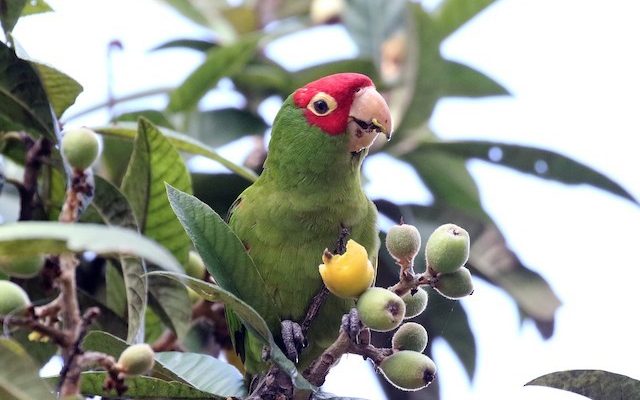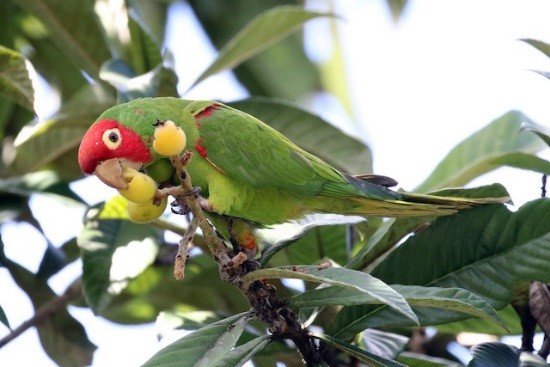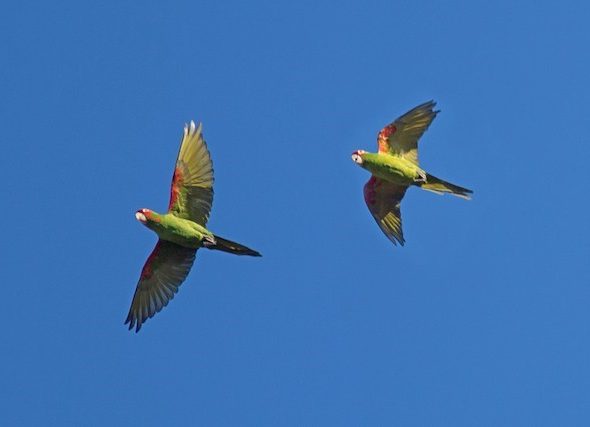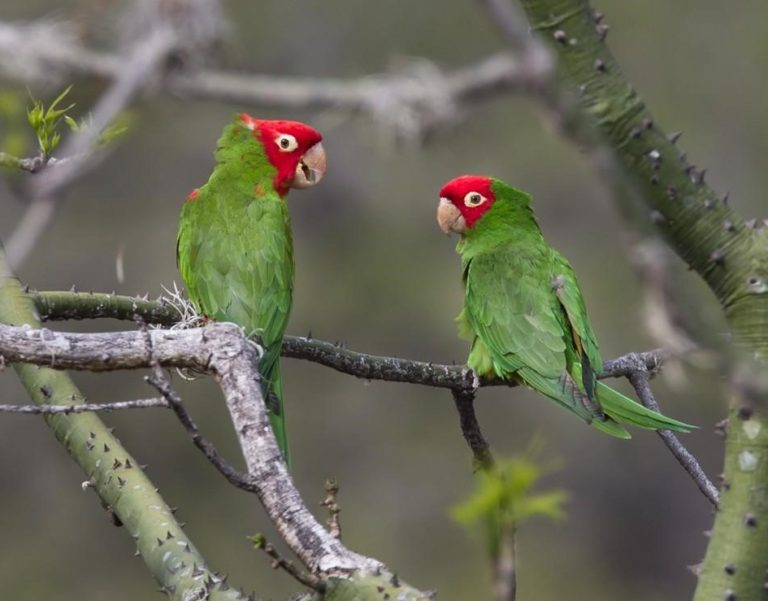Birdfinding.info ⇒ Following a sharp decline, it has become uncommon and localized in its natural range. In Ecuador, it can be found at Río Silanche Bird Sanctuary, Machalilla National Park, and the Jama-Coaque, Pacoche, Manglar Churute, Buenaventura, and Jorupe Reserves; and in Peru at Cerros de Amotape National Park, Coto de Caza El Angolo, Laquipampa Wildlife Reserve, and Chaparri Ecological Reserve. Consistent sites for urban populations include Black Point (Honolulu), Aimakapa Pond (Kona), Fort Mason and Sue Bierman Parks (San Francisco), Daines Drive west of Baldwin Avenue (Los Angeles), Brewer Park (South Miami), Miraflores Central Park (Lima), and Túria Gardens (Valencia).
Red-masked Parakeet
Psittacara erythrogenys
Endemic to the Tumbesian biome of Ecuador and Peru; introduced elsewhere.
Native to the dry forest region of the Pacific slope of Ecuador (north to Esmeraldas) and northwestern Peru (south to southern Lambayeque), where it occurs in deciduous forest, scrub, and mixed agricultural areas.
Native populations declined significantly in the 1980s due to capture for the pet trade, which eventually resulted in several introduced urban populations. Those that appear to be established are in San Francisco, Los Angeles, and San Diego, California, southeastern Florida, Hawaii (Honolulu and the Kona coast), north-coastal Puerto Rico, Lima, Peru, and Valencia, Spain. The San Francisco population is the largest, with several hundred birds, and has been afforded legal protection—unusual for an exotic species.
Identification
Adult is distinctive: a green parakeet with a striking red helmet and bold bare yellowish eyerings.
Red shoulders are often visible at rest. In flight, the leading edge of the underwings shows a broad red bar.

Red-masked Parakeet. (Diamond Head Crater Park, Honolulu, Hawaii; November 14, 2006.) © Michael Walther

Red-masked Parakeet. (Brewer Park, Miami, Florida; March 4, 2017.) © David McQuade

Red-masked Parakeet. (Point Loma, California; February 11, 2019.) © Sia McGown

Red-masked Parakeet. (Coral Gables, Florida; February 16, 2019.) © Hugh Whelan

Red-masked Parakeet. (Jorupe Reserve, Loja, Ecuador; March 2, 2018.) © Roger Ahlman

Red-masked Parakeet. (Kaloko Fishpond, Kaloko-Honokohau National Historical Park, Hawaii; January 14, 2017.) © Sharif Uddin

Red-masked Parakeet. (Brewer Park, Miami, Florida; March 4, 2017.) © David McQuade

Red-masked Parakeets, blotchier than most. (Fort Mason Park, San Francisco, California; March 12, 2018.) © David Assmann

Red-masked Parakeet, showing red bar on leading edge of underwing. (Brewer Park, Miami, Florida; May 6, 2017.) © Paul Hueber

Red-masked Parakeets, showing red bar on leading edge of underwing. (Diamond Head Crater Park, Honolulu, Hawaii; November 14, 2006.) © Michael Walther

Red-masked Parakeet, showing red bar on leading edge of underwing. (Matheson Hammock Park, Miami, Florida; March 23, 2015.) © Steven Mlodinow

Red-masked Parakeets, showing red bar on leading edge of underwing. (Fort Mason Park, San Francisco, California; September 20, 2015.) © Donna Pomeroy
Immatures have little or no red on the face and are potentially mistaken for several closely related species that may occur with it in areas where it is introduced.

Red-masked Parakeet, immature showing red flecks on the face. (Wheeler Park, Los Angeles, California; January 21, 2018.) © Thomas Miko

Red-masked Parakeet, immature. (Isla Santay, Guayas, Ecuador; June 22, 2017.) © Michael Clay
Cf. Mitred Parakeet. Their natural ranges are not known to overlap, but introduced populations of Mitred and Red-masked Parakeets occur together in several cities. Mitred has highly variable plumage, making it an inherently confusing species, whereas adult Red-masked has a consistent pattern. Immature plumages of the two species can be essentially identical, and are usually identifiable only by their association with adults.
Adult Red-masked is distinguished by its characteristic red hood, which tapers toward the chin. The red area sometimes has a rough border and a few stray specks, but usually gives a distinctly helmet-like impression. Mitred can show essentially the same amount of red on the head, but its distribution is blotchier, with scattered specks of red over a wider area. Red-masked shows red on the shoulder of the folded wing and a distinct red bar on the leading edge of the underwing, where Mitred shows little or no red.
Voice can be a useful clue. Mitred and Red-masked have similar repertoires, but Red-masked’s calls tend to be higher-pitched: its nasal creaking has a jay-like quality and its screams are thin and piercing. Mitred’s nasal creaking is mellower and its screams are harsher, less shrill than Red-masked’s.
Cf. White-eyed Parakeet. Introduced populations of White-eyed and Red-masked Parakeets occur together in southeastern Florida, and possibly elsewhere. Immature Red-masked can strongly resemble White-eyed, as both can show red on the shoulders and the leading edge of the underwing, but usually little or no red on the head.
In flight, White-eyed has a distinctive underwing pattern: a broad red bar on the leading edge with a broad yellow bar beside it. White-eyed can also have flecks of red on its neck or the back of the head, usually sparse and patternless, whereas the red flecks on immature Red-masked are typically concentrated on the crown, face, and throat.
Cf. Other Psittacara Parakeets. In areas where it has been introduced, immature and subadult Red-masked Parakeets are potentially confused with immature and adult plumages of several other members of its genus.
Notes
Monotypic species.
IUCN Red List Status: Near Threatened.
References
Alderfer, J., and J.L. Dunn. 2014. National Geographic Complete Birds of North America (Second Edition). National Geographic Society, Washington, D.C.
BirdLife International. 2018. Psittacara erythrogenys. The IUCN Red List of Threatened Species 2018: e.T22685672A132059066. http://dx.doi.org/10.2305/IUCN.UK.2018-2.RLTS.T22685672A132059066.en. (Accessed May 8, 2019.)
Collar, N., P. Boesman, and C.J. Sharpe. 2018. Red-masked Parakeet (Psittacara erythrogenys). In Handbook of the Birds of the World Alive (J. del Hoyo, A. Elliott, J. Sargatal, D.A. Christie, and E. de Juana, eds.). Lynx Edicions, Barcelona. https://www.hbw.com/node/54639. (Accessed July 30, 2018.)
Forshaw, J.M. 2010. Parrots of the World. Princeton University Press, Princeton, N.J.
Kalodimos, N.P. 2013. Red-masked Parakeet (Psittacara erythrogenys), version 1.0. In Neotropical Birds Online (T.S. Schulenberg, ed.). Cornell Lab of Ornithology, Ithaca, N.Y. https://doi.org/10.2173/nb.rempar.01.
Ridgely, R.S., and P.J. Greenfield. 2001. The Birds of Ecuador, Volume II: Field Guide. Cornell University Press, Ithaca, N.Y.
Schulenberg, T.S., D.F. Stotz, D.F. Lane, J.P. O’Neill, and T.A. Parker. 2007. Birds of Peru. Princeton University Press, Princeton, N.J.

